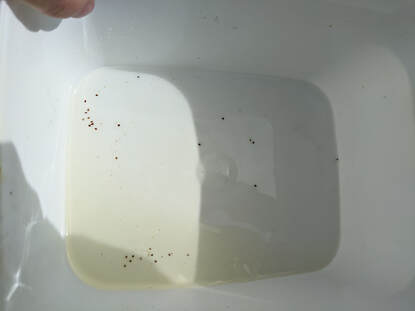 Welcome to the A2B2 Flow Hive Team blog. If you are looking for the general A2B2 blog, please click on the blog tab at the top of the page. On Sunday, we checked the Flow Hive and the split hive in preparation for winter preparation. What does that mean? Well, first since both hives were looking a little weak at our last check (likely due to high mite counts - Please see our last post entitled This is How You Lose the Mite War), we wanted to make sure they were both queenright. If one didn't have a queen, then we could combine the two weak hives into one strong hive for the winter. Good news, both hives were queenright, so no combining needed. Second, we fed both hives 3 quart jars of 2:1 sugar syrup to fatten up their winter stores of honey. We also made sure that frames of honey in the mediums were in the middle of the box and removed some shallow frames from the medium super of the split hive (oops!). These short frames would've made it almost impossible for the bees to reach the honey stored in them over the winter. Third, we placed mouse guard over the entrances of the hives because this is the time of year that mice are looking for a nice, warm, dark place with plenty of food to spend the winter (i.e. your hive). We also replaced one of the split hive's boxes with a nicer one that had fewer holes for mice to get into and that would let out heat in the winter. At our next check we will be winterizing the hives. This means wrapping them with roofing felt, placing quilt boxes on top of the hives to help insulate and absorb moisture, treating the hives with an Oxalic Acid dribble to kill any adult mites left in the hive, placing a foam board under the outer cover for insulation, and stocking the hives with dry sugar (as temperatures drop, the bees aren't able to take in the sugar syrup anymore). The last check of the season is on Saturday, October 30th, 2021 at 11am. Hope you can bee there! :) If you would like to join the A2B2 Flow Hive Team or would like to know more about the Flow Hive in general, please contact Jen Haeger at [email protected]. All club members are welcome regardless of experience level! :)
0 Comments
 Well folks, after having only seen 1 mite on our previous mite counts, our last mite test on Saturday revealed 20 mites per 300 bees in the Flow Hive and 30 mites per 300 bees in the split hive!!! Sad, sad news friends, and a warning to all! YOU MUST CONTINUE TO MITE CHECK THROUGHOUT THE FALL!!! Why? This is the time of the year when 2 things happen: 1. Mite levels are peaking whilst bee numbers are declining, and 2. Other hives overrun with mites (not yours I'm sure), that are owned by beekeepers who have done nothing for or about mites other than "let the strong, mite resistant hives survive and the mite susceptible hives die," have become mite bombs. What is a mite bomb? When a hive succumbs to Varroa destructor infection, it does not go quietly and take the mites down with it. Oh no. It explodes and bees carrying multiple mites fly to all the surrounding hives and infect them. So? So, this means that your hives, which you have been diligently testing all summer and have had low mite counts, will now have skyrocketing mite levels that will weaken and perhaps kill them if you don't catch it and treat. Also, you are running out of time to use many mite treatments which require certain temperatures to work properly. What can you do? Keep checking and treat with the appropriate mite treatments as dictated by the weather, amount of brood present, and whether or not you still have honey supers on. We treated both hives with FormicPro strips and will treat again in a few weeks with an Oxalic Acid drip, still I worry that the damage from the mites (weakening the bees physically, viruses, etc.) may already have been done. Our next check will be this Sunday, October 10th at 11:00am. Hope you can bee there! If you would like to join the A2B2 Flow Hive Team or would like to know more about the Flow Hive in general, please contact Jen Haeger at [email protected]. |
What is a Flow Hive?
A Flow Hive is a Langstroth-style hive system with plastic frames which allow honey to be harvested directly from the hive. www.honeyflow.com/pages/how-flow-works Archives
May 2024
Categories |

 RSS Feed
RSS Feed
